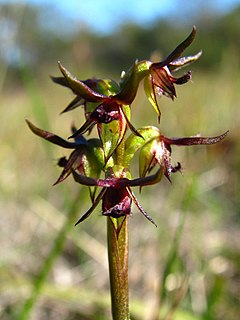
The peanut, also known as the groundnut, goober (US), pindar (US) or monkey nut (UK), and taxonomically classified as Arachis hypogaea, is a legume crop grown mainly for its edible seeds. It is widely grown in the tropics and subtropics, being important to both small and large commercial producers. It is classified as both a grain legume and, due to its high oil content, an oil crop. World annual production of shelled peanuts was 44 million tonnes in 2016, led by China with 38% of the world total. Atypically among legume crop plants, peanut pods develop underground (geocarpy) rather than above ground. With this characteristic in mind, the botanist Carl Linnaeus gave peanuts the specific epithet hypogaea, which means "under the earth".

Arachis is a genus of about 70 species of annual and perennial flowering plants in the family (Fabaceae), native to South America, and was recently assigned to the informal monophyletic Pterocarpus clade of the Dalbergieae. At least one species, the peanut, is a major food crop species of global importance; some of the other species are cultivated for food to a small extent in South America. Other species such as A. pintoi are cultivated worldwide as forage and soil conditioner plants, with the leaves providing high-protein feed for grazing livestock and a nitrogen source in agroforestry and permaculture systems.

Diselma archeri is a species of plant of the family Cupressaceae and the sole species in the genus Diselma. It is endemic to the alpine regions of Tasmania's southwest and Central Highlands, on the western coast ranges and Lake St. Clair. It is a monotypic genus restricted to high altitude rainforest and moist alpine heathland. Its distribution mirrors very closely that of other endemic Tasmanian conifers Microcachrys tetragona and Pherosphaera hookeriana.
Arachis ipaensis is a herb in the Faboideae subfamily. This plant is cited as gene sources for research in plant biology of peanut. Its genome has been sequenced.
Arachis batizocoi is a herb native to Bolivia and Paraguay. This plant is cited as gene sources for research in plant biology of peanut.
Arachis cardenasii is a herb in the Faboideae family. This plant is cited as gene sources for research in plant biology of peanut ; for example, Cercospora leaf spot resistance.
Arachis correntina is a herb native to Argentina and Paraguay. This plant is cited as gene sources for research in plant biology of peanut.
Arachis diogoi is a perennial herb found in Africa, Indian Ocean and South America. This plant is cited as gene sources for research in plant biology of peanut.

Arachis duranensis is a herb found in South America, specially in North Argentina, Bolivia, and Paraguay. This plant is cited as gene sources for research in plant biology of peanut.
Bean yellow mosaic virus is a plant pathogenic virus in the genus Potyvirus and the virus family Potyviridae. Like other members of the Potyvirus genus, it is a monopartite strand of positive-sense, single-stranded RNA surrounded by a capsid made for a single viral encoded protein. The virus is a filamentous particle that measures about 750 nm in length. This virus is transmitted by species of aphids and by mechanical inoculation.

Archer's lark, also known as Liben lark is a species of lark in the family Alaudidae. It is found in Somalia, Somaliland and Ethiopia. Its natural habitats are subtropical or tropical dry shrubland and subtropical or tropical dry lowland grassland. It is threatened by habitat loss. The bird's common name and binomial commemorate the British explorer and colonial official Sir Geoffrey Francis Archer.
Antonio Krapovickas was an Argentine agronomist.
The Legume Information System (LIS), is legume sciences portal specifically for legume breeders and researchers, established and supported by the Agricultural Research Service of the United States Department of Agriculture. The mission of the Legume Information System is "to facilitate discoveries and crop improvement in the legumes," in particular to improve crop yields, their nutritional value, and our understanding of basic legume science.

Rajeev Kumar Varshney is an agricultural scientist, specializing in genomics, genetics, molecular breeding and capacity building in developing countries. Varsheny is currently the Research Program Director- Genetic Gains that includes several units viz. Genomics & Trait Discovery, Forward Breeding, Pre-Breeding, Cell, Molecular Biology & Genetic Engineering, Seed Systems, Biotechnology- ESA, Sequencing and Informatics Services Unit, and Genebank ; and Director, Center of Excellence in Genomics & Systems Biology at the International Crops Research Institute for the Semi-Arid Tropics (ICRISAT), a global agricultural research institute. He holds Adjunct/Honorary/Visiting Professor positions at 10 academic institutions in Australia, China, Ghana, Hong Kong and India, including Murdoch University, The University of Western Australia, University of Queensland, West Africa Centre for Crop Improvement, University of Hyderabad, Chaudhary Charan Singh University and Professor Jayashankar Telangana State Agricultural University.

Eucalyptus archeri, also known as alpine cider gum, is a mallee or a small tree that is endemic to Tasmania. It has smooth white or greyish bark, lance-shaped adult leaves, flower buds in groups of three, white flowers and conical to barrel-shaped fruit. It intergrades with E. gunnii.
Joseph ("Joe") Smartt, was a British geneticist with major contributions to the knowledge of crop evolution, especially of grain legumes.

Genoplesium archeri, commonly known as the elfin midge orchid and as Corunastylis archeri in Australia, is a small terrestrial orchid endemic to south-eastern Australia. It has a single thin leaf fused to the flowering stem and up to fifteen small, hairy, yellowish green flowers with purple stripes. It grows in a wide range of habitats in New South Wales, Victoria and Tasmania.
Asteridea archeri is a herb in the Asteraceae family, which is endemic to Western Australia. It was first described in 2000 by Philip Short. It is found growing on gypsum dunes in salt lakes to heights from 20 cm to 1 m. Its white flowers may seen from September to October in Beard's Eremaean Province. There are no synonyms.

Dicrastylis archeri is a species of plant within the genus, Dicrastylis, in the family Lamiaceae. It is endemic to the south-west of Western Australia.

Venkatrao K. Badami was an Indian agronomist and a pioneer of plant breeding. Working in the Mysore Department of Agriculture, he was among the first to make use of X-ray induced mutations in the search for useful variations for breeding sugarcane varieties in 1933.









